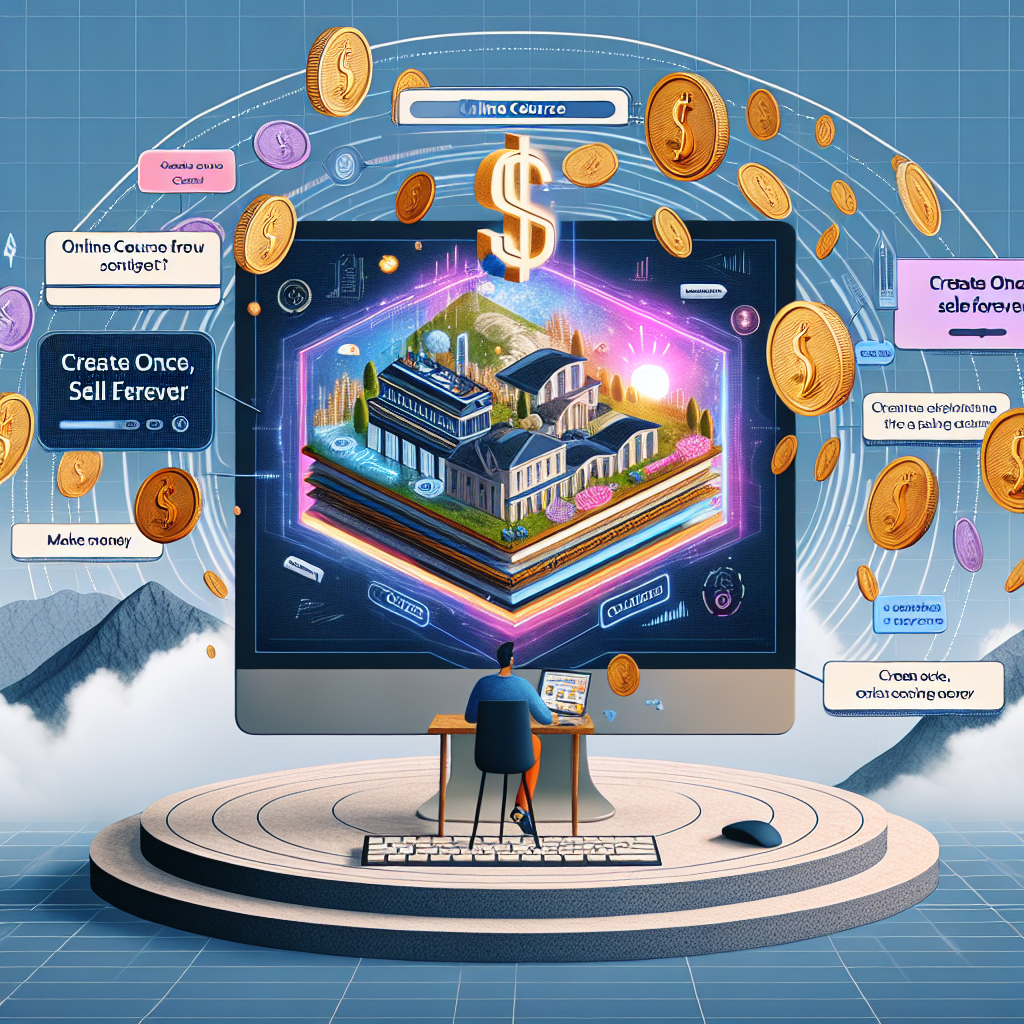-
Table of Contents
“Unlock Endless Earnings: Create Once, Profit Forever with 2025’s Online Courses!”
Introduction
In the rapidly evolving digital landscape of 2025, creating and selling online courses has emerged as a lucrative avenue for generating passive income. As the demand for flexible, self-paced learning continues to rise, educators, professionals, and entrepreneurs are capitalizing on their expertise by developing courses that require a one-time creation effort but can be sold indefinitely. This model not only allows for the monetization of specialized knowledge but also offers the potential for a sustainable income stream with minimal ongoing effort. By leveraging platforms that facilitate course creation and distribution, individuals can reach a global audience eager to acquire new skills and insights, making online courses a compelling opportunity for financial growth in the modern economy.
Maximizing Passive Income: Creating Evergreen Online Courses for 2025
In the rapidly evolving digital landscape of 2025, the pursuit of passive income has become a focal point for many individuals seeking financial independence. One of the most effective strategies to achieve this goal is by creating evergreen online courses. These courses, designed to remain relevant and valuable over time, offer a unique opportunity to generate income continuously without the need for constant updates or revisions. As we delve into the intricacies of this approach, it becomes evident that the key to success lies in understanding the dynamics of course creation and leveraging the tools available in today’s technologically advanced world.
To begin with, the concept of evergreen content is central to maximizing passive income through online courses. Unlike time-sensitive material, evergreen content remains pertinent regardless of when it is accessed. This timelessness ensures that the course can be marketed and sold repeatedly without losing its appeal. Consequently, selecting a topic that possesses enduring relevance is crucial. Subjects such as personal development, language learning, and foundational business skills often exhibit this quality, making them ideal candidates for evergreen courses.
Once a suitable topic is identified, the next step involves meticulous planning and content creation. It is essential to structure the course in a manner that facilitates easy comprehension and engagement. This can be achieved by breaking down complex concepts into digestible modules, incorporating multimedia elements such as videos, quizzes, and interactive exercises. These components not only enhance the learning experience but also cater to diverse learning styles, thereby broadening the course’s appeal.
In addition to content creation, the choice of platform plays a pivotal role in the success of an online course. With numerous options available, ranging from established platforms like Udemy and Coursera to self-hosted solutions, it is imperative to select one that aligns with the course’s objectives and target audience. Established platforms offer the advantage of a built-in audience and marketing support, while self-hosted solutions provide greater control over pricing and branding. Weighing these factors carefully can significantly impact the course’s reach and profitability.
Furthermore, effective marketing strategies are indispensable in ensuring the course’s visibility and sustained sales. Leveraging social media, email marketing, and search engine optimization can drive traffic to the course, while collaborations with influencers and industry experts can enhance credibility and expand reach. Additionally, offering free previews or limited-time discounts can entice potential learners and stimulate initial interest.
As the course gains traction, it is important to monitor feedback and performance metrics. This data provides valuable insights into areas of improvement and can guide future updates or expansions. While the goal is to create a course that requires minimal maintenance, occasional updates may be necessary to incorporate new developments or address learner feedback, thereby maintaining the course’s relevance and quality.
In conclusion, creating evergreen online courses in 2025 presents a viable pathway to generating passive income. By selecting a timeless topic, crafting engaging content, choosing the right platform, and implementing effective marketing strategies, individuals can create courses that not only provide financial rewards but also contribute to the dissemination of knowledge. As the digital landscape continues to evolve, those who embrace this approach stand to benefit from the enduring demand for quality online education.
The Future of E-Learning: Designing Courses That Sell Themselves in 2025

In the rapidly evolving landscape of 2025, the e-learning industry continues to flourish, offering unprecedented opportunities for individuals to monetize their expertise. The concept of creating online courses that require a one-time effort yet yield perpetual financial returns is particularly appealing. As technology advances and the demand for flexible learning solutions grows, designing courses that effectively sell themselves has become a viable and lucrative endeavor. To achieve this, it is essential to understand the key elements that contribute to the success of such courses.
First and foremost, identifying a niche market is crucial. In 2025, the e-learning market is saturated with a plethora of courses covering a wide range of topics. Therefore, pinpointing a specific area where demand exceeds supply can significantly enhance the potential for success. Conducting thorough market research to understand the needs and preferences of the target audience is imperative. This involves analyzing trends, identifying gaps in existing offerings, and determining the unique value proposition that your course can provide.
Once a niche is identified, the next step is to create high-quality content that resonates with learners. In an era where attention spans are dwindling, it is vital to design courses that are engaging, interactive, and visually appealing. Incorporating multimedia elements such as videos, infographics, and quizzes can enhance the learning experience and maintain learner interest. Additionally, structuring the course in a logical and coherent manner, with clear learning objectives and outcomes, ensures that learners can easily follow and absorb the material.
Moreover, leveraging technology to automate and streamline the course delivery process is essential. In 2025, advancements in artificial intelligence and machine learning have enabled the creation of personalized learning experiences. By utilizing these technologies, course creators can tailor content to individual learners’ needs, thereby increasing engagement and satisfaction. Furthermore, employing automated marketing tools can help reach a wider audience and drive sales without constant manual intervention.
In addition to content creation and delivery, establishing a strong online presence is vital for the success of self-selling courses. Building a personal brand and establishing credibility in the chosen niche can significantly impact the course’s marketability. This can be achieved through various means, such as maintaining an active presence on social media platforms, engaging with potential learners through webinars or live sessions, and collaborating with influencers or industry experts. By positioning oneself as an authority in the field, course creators can instill trust and confidence in prospective learners.
Furthermore, pricing strategies play a crucial role in the long-term success of online courses. In 2025, the competitive nature of the e-learning market necessitates a careful balance between affordability and perceived value. Offering tiered pricing options, such as basic and premium packages, can cater to different segments of the audience and maximize revenue potential. Additionally, providing limited-time discounts or bundling courses with complementary resources can create a sense of urgency and incentivize purchases.
Finally, continuous improvement and adaptation are key to sustaining the success of self-selling courses. Gathering feedback from learners and analyzing course performance metrics can provide valuable insights for refining and updating content. Staying abreast of industry trends and technological advancements ensures that the course remains relevant and competitive in the ever-changing e-learning landscape.
In conclusion, the future of e-learning in 2025 presents abundant opportunities for individuals to create online courses that sell themselves. By identifying a niche market, creating high-quality content, leveraging technology, establishing a strong online presence, implementing effective pricing strategies, and continuously improving the course, individuals can tap into the potential of this thriving industry and achieve financial success.
2025 Guide to Financial Freedom: Crafting and Selling Perennial Online Courses
In the rapidly evolving digital landscape of 2025, the pursuit of financial freedom has taken on new dimensions, with online courses emerging as a lucrative avenue for generating passive income. The concept of creating a course once and selling it indefinitely has gained traction, offering individuals the opportunity to leverage their expertise and knowledge in a sustainable manner. As the demand for online learning continues to grow, understanding how to craft and market perennial online courses can be a game-changer for those seeking financial independence.
To begin with, identifying a niche that aligns with your expertise is crucial. The success of an online course hinges on its relevance and the value it provides to learners. In 2025, the most successful courses are those that address specific problems or skills gaps in the market. Conducting thorough research to understand current trends and demands can help pinpoint a niche that not only resonates with your knowledge but also appeals to a broad audience. Once a niche is identified, the next step is to design a comprehensive curriculum that is both engaging and informative.
Creating high-quality content is paramount. In an era where information is abundant, learners are discerning and seek courses that offer depth and clarity. Therefore, investing time in developing well-structured modules, incorporating multimedia elements, and ensuring the content is up-to-date is essential. Additionally, employing interactive elements such as quizzes, assignments, and discussion forums can enhance the learning experience, making the course more appealing and effective.
Transitioning from content creation to marketing, it is imperative to establish a strong online presence. In 2025, digital marketing strategies have become more sophisticated, with social media platforms, search engine optimization, and email marketing playing pivotal roles in reaching potential learners. Building a personal brand and leveraging platforms like LinkedIn, Instagram, and YouTube can significantly boost visibility. Furthermore, collaborating with influencers or industry experts can lend credibility and expand your reach to a wider audience.
Pricing strategy is another critical aspect to consider. Striking a balance between affordability and perceived value is key to attracting and retaining learners. Offering tiered pricing models, where learners can choose between basic and premium packages, can cater to different budgets while maximizing revenue potential. Additionally, providing limited-time discounts or bundled offers can create a sense of urgency and encourage more enrollments.
Once the course is launched, maintaining its relevance is vital for long-term success. Regularly updating the content to reflect new developments in the field ensures that the course remains valuable to learners. Moreover, gathering feedback from participants can provide insights into areas for improvement and help refine the course over time. Engaging with learners through follow-up emails or webinars can also foster a sense of community and encourage repeat business.
In conclusion, the potential to achieve financial freedom through perennial online courses in 2025 is immense. By carefully selecting a niche, creating high-quality content, employing effective marketing strategies, and maintaining course relevance, individuals can build a sustainable source of income. As the digital education landscape continues to expand, those who adapt and innovate will find themselves well-positioned to reap the benefits of this dynamic and rewarding endeavor.
Conclusion
In 2025, creating and selling online courses presents a lucrative opportunity for generating passive income. By leveraging platforms that host and market educational content, individuals can capitalize on their expertise and reach a global audience. The key to success lies in identifying niche topics with high demand, ensuring the course content is comprehensive and engaging, and utilizing effective marketing strategies to attract and retain learners. Once created, these courses can be sold repeatedly with minimal ongoing effort, providing a sustainable income stream. As the digital education market continues to expand, those who invest in quality course creation and strategic promotion are well-positioned to benefit financially.
